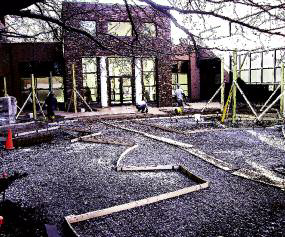technique
For more than 50 years, lots of swimming pool builders, plasterers and service technicians have operated under the assumption that the plaster dust they commonly see during the first two weeks after plaster application is normal, unavoidable and acceptable. None of that is
Everyone knows that muriatic acid, when applied directly to a plaster finish, will dissolve and remove material from the surface. This is why the practice of "acid washing" is so widespread: It removes surface stains and restores a finish to an approximation of what it looked like when new. The problem with this acid application, of course, is that it
Have you ever noticed how often the costliest part of a project turns out to be something that will ultimately be hidden from view? This happens quite frequently in projects involving any sort of slope, where the piers and grade beams beneath swimming pools, for example, can cost far more than the rest of the overall project. In my own work, I’ve noticed this budgetary quirk most frequently when it comes to retaining walls, where providing the foundation they need to withstand the forces applied by a slope can be startlingly extensive and expensive. It’s not what you’d call glamorous work, but it certainly is important – and will vanish completely from view. Most often, we’re called on to build these walls when
Every time I open a landscape trade magazine, I’m bombarded by ads from just about every paver manufacturer on the planet. From the newest faux-stone concrete pavers and ADA-compliant bricks to granite, flagstone, mica and other slab species, we have more choices than ever before for our projects. Some professionals approach this wealth of possibilities and play it safe – not caring so much about what’s the latest and greatest but focusing instead on what’s most familiar and time-tested and being interested in little more than providing clients with surfaces that can safely be walked on. Fortunately, however, there are lots of us who take a different view, putting care and thought into the materials we select for our walkways, patios and terraces and working closely with our clients to make certain the resulting surfaces meet their needs. In other words, there’s
For a good while now, I’ve been on the lookout for books that define the health benefits of swimming and other forms of aquatic exercise. I’ve largely come up empty, with only a couple of worthy exceptions. It’s been important to me for two reasons: First, I’m convinced (as others in this magazine have argued) that the watershaping industry is doing both itself and its clients a disservice by not promoting the remarkable healthfulness of aquatic activity. I think this is a deficit we desperately need to address – and also that this effort must begin on a solid base of knowledge and fact. Second, as I progress through my forties, I’m finding that running is becoming more and more difficult because of hip problems; my intention is to turn to the water to maintain my physical fitness, but I want to know more about it and how to do it right. So far, the best resource for information about swimming I’ve found is The Complete Book of Swimming by Dr. Phillip Whitten (Random House, 1994). It’s older than some other volumes I’ve found, but I think it’s the best because
As a rule, I’ve resisted the temptation to cover books about sales in these columns. I’ve read a great many of those books through the years, and I’ve always tended to think of them as buffets where I pick up useful insights, wisdom or motivation – and ignore suggestions that don’t seem as useful. But no single book I’ve run into has proved to be so helpful that I’ve felt compelled to share it with you here. At last, however, I’ve found an exception – a wonderful book by emerging sales guru Jeffrey Gitomer called The Little Red Book of Selling (Bard Press, 2004). I picked up a copy of this compact 220-page volume two years ago at an airport bookstore (and have picked up a couple more since then), and I see why Gitomer is becoming one of the leading voices when it comes to sales. He may not have reached the same status as Zig Ziglar or Dale Carnegie (both of whom I admire greatly), but his star is
Last time, I described (at great length, as you may have noticed) what happens in the time between my initial phone conversation with clients and a point just ahead of my formal presentation of a design. It's an involved process that uses all of the information I've gleaned from my clients about what they want, what they think they need and what they ultimately expect to have in their backyard environments. It's about understanding the underlying circumstances, deciding what should be done and, finally, assembling all of that insight into a
Last time, I described (at great length, as you may have noticed) what happens in the time between my initial phone conversation with clients and a point just ahead of my formal presentation of a design. It's an involved process that uses all of the information I've gleaned from my clients about what they want, what they think they need and what they ultimately expect to have in their backyard environments. It's about understanding the underlying circumstances, deciding what should be done and, finally, assembling all of that insight into a
Tackling large, custom watershaping projects is all about the synergy between my clients and me: There simply must be a fit, or the process just won't work. Last month, we discussed the importance of setting up proper expectations from the moment a client makes initial contact and you pick up the phone. This time, I'll cover what happens if the early stages of the relationship go well enough that a face-to-face meeting is in order. This is the session during which I discover whether or not there's truly a
Tackling large, custom watershaping projects is all about the synergy between my clients and me: There simply must be a fit, or the process just won't work. Last month, we discussed the importance of setting up proper expectations from the moment a client makes initial contact and you pick up the phone. This time, I'll cover what happens if the early stages of the relationship go well enough that a face-to-face meeting is in order. This is the session during which I discover whether or not there's truly a




















